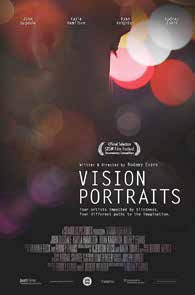Vision Portraits, opening August 30 in the Bay Area, is out gay writer-director Rodney Evans’ remarkable documentary about visually-impaired artists. Evans uses his own experiences of losing his sight from retinitis pigmentosa as a jumping off point to explore the creative processes of HIV+ photographer John Dugdale, dancer Kayla Hamilton and writer Ryan Knighton. His stunning film investigates how and why blindness is not limiting for these artists.
The filmmaker recently met with me for the San Francisco Bay Times to talk about making Vision Portraits.
Gary M. Kramer: How did you conceive of this documentary and incorporating your story and experiences?
Rodney Evans: I shared a lot of experiences the [artists] went through. I know what it’s like to walk around with a red-and-white cane. I know the pros and cons and stigmas attached to that. I know what it’s like to pass for fully sighted for as long as possible—until it becomes completely impossible. Initially, I thought I’d be more of a framing device, and talk about my condition and experiences at the beginning and what led me to wanting to explore the creative processes of these blind or severely visually-impaired artists, and why I was searching out these specific people and what did I hope to glean from them from having a dialogue and looking at their artistic process.
Gary M. Kramer: What touched you personally about each artist’s work?
Rodney Evans: With Ryan, it was this memoir that he wrote called Cockeyed, which was profoundly moving and impactful to me when I read it. I’ve known John Dugdale’s work and was appreciative of it. I showed him a diary film [about coming out], and my vulnerability in that film led him to trust me that I was the right person and I would tell the story in a respectful, tasteful way. Kayla, I met through a colleague in the dance department. I wanted dance to be a part of the film. For me, it’s bravery on a different level. You’re using your body to navigate space as an art form and there are so many obstacles and ways in which that can go wrong in a very public way.
 Gary M. Kramer: What I like about your film is that you do not sentimentalize these artists. Can you discuss your approach and how you presented the artists?
Gary M. Kramer: What I like about your film is that you do not sentimentalize these artists. Can you discuss your approach and how you presented the artists?
Rodney Evans: Every artist has their own issues and obstacles that they need to work through in order to create within their medium. I wanted to paint a multi-dimensional, nuanced portrait of each person that had the pros and cons and shades of gray and didn’t fall into the trope of the super-crip or inspirational porn. You very much see the dark side of their journey, and their wrestling with issues and assistance and what it takes for an artist to find their voice within a piece. That was always front and center. I wasn’t interested in making hagiography.
Gary M. Kramer: Your visual approach to the narrative includes using irises or blurring focus to convey the loss of sight. Can you describe the film’s style?
Rodney Evans: It was really important for me to incorporate each individual’s subjective experience of vision as they described it. Whenever we could convey visually for the audience in a visceral way what the character was talking about, we would do it. So when I’m on the subway and the periphery is blacked out, or made more abstracted and you see the center really clearly, it’s important for the audience to see that that was my point of view walking through that aisle on the train and how that differs from the fully-sighted person’s perspective, which we cut to later. We held magnifying glasses over Ryan’s book of poetry, where we’d shift focus where one word would come into focus and then be obscured by light and conveying that experience of him on stage and trying to pass as a sighted poet and failing and not being able to see the words on the page.
Gary M. Kramer: There is an emphasis on passing as sighted. What observations do you have about coming out as visually impaired?
Rodney Evans: It was a relief, frankly, because there was so much miscommunication and wrongly interpreted signals that put me in a dangerous position. If I’m commuting to Philadelphia for my job and I’m going through New York’s Penn station, and as a young black man, I’m bumping into 12 people, that is apt to be perceived as a hostile, aggressive act. But If I’m using a red and white cane, that immediately diffuses the situation.
There is this huge gulf between the lived experiences of people within this country and what’s reflected back at them in film and television. What does that erasure perpetuate? What kind of fear, what kinds of stigmas and misperceptions does that lack of knowledge from accurate representation and honest portrayals perpetuate, and what does it take to stop underestimating what a disabled person can do both in front of, or behind, the camera?
© 2019 Gary M. Kramer
Gary M. Kramer is the author of “Independent Queer Cinema: Reviews and Interviews,” and the co-editor of “Directory of World Cinema: Argentina.” Follow him on Twitter @garymkramer
Recent Comments